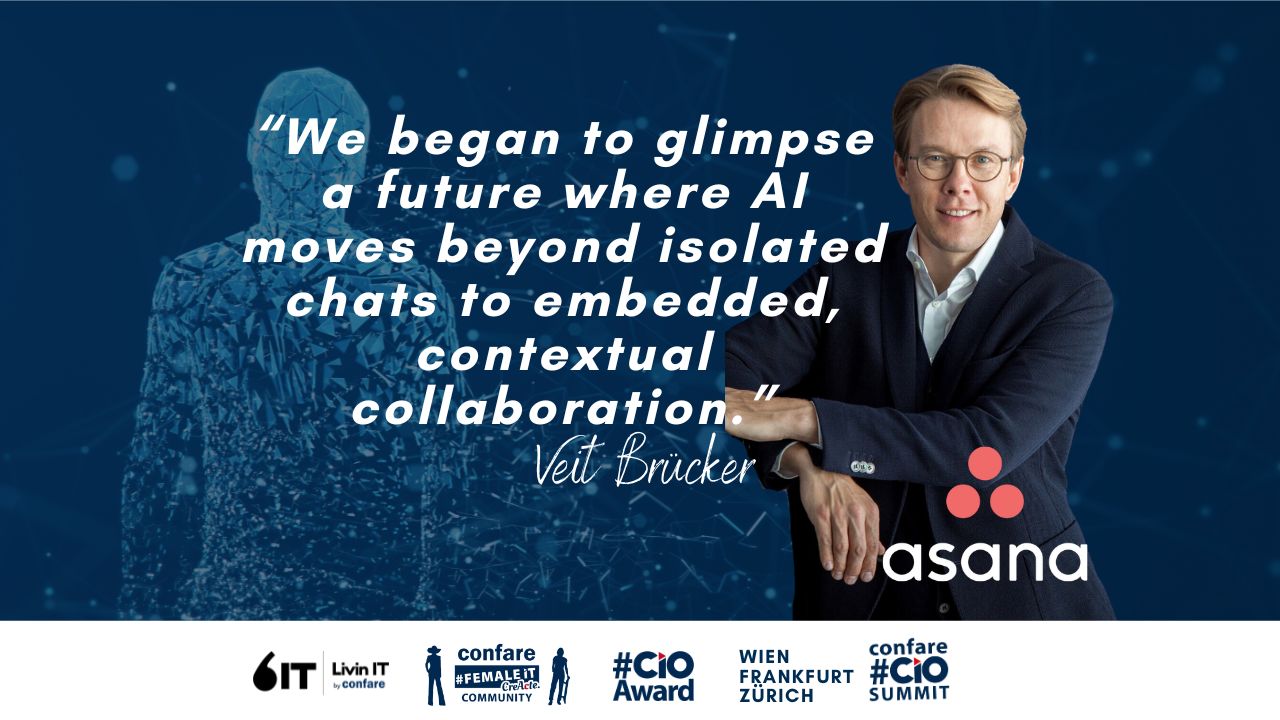Veit Brücker, Asana, Elevating AI: From Tool to Teammate
On September 25th, we invite you to the Confare CIOSUMMIT Zurich. With the presentation of the Swiss CIOAWARD and the selection of the CIO of the Year, it is the most important IT management event in Switzerland.
Joining us for the first time as a partner: Asana. This exciting company from Silicon Valley is rapidly growing and is known as the #1 work management platform, where work connects to goals. Over 150,000 customers worldwide and in Swizerland like Viessmann, Amazon, Mammut Sports Group or Rieter rely on Asana to manage and automate everything from goal setting and tracking to capacity planning to product launches. Increasingly, Asana sees itself as a partner of the CIO in shaping the new world of work with AI.
Veit Brücker, General Manager DACH at Asana, spoke with us about the development and perspectives of Asana, the role of AI in the new world of work, and collaboration with CIOs.
Want to meet the New Work experts from Asana in person? Participation in the Confare CIOSUMMIT is free of charge for IT decision-makers. Here you can learn all about the high-profile conference program and registration options. We look forward to seeing you there.
Can you tell us about the development of Asana? Where are your roots, and how is the company changing in light of current market and technology developments?
Asana is providing work management solutions for Enterprises globally, finally enabling teamwork without email. This started nearly twenty years ago with the belief that there had to be a better way for teams to work together than the status quo of email overload and unproductive status meetings.
Founded by Dustin Moscovitz and Justin Rosenstein whose combined experience at both Google and Facebook, led them to become frustrated with seeing teams of tremendously smart people get stuck not doing the work that mattered, but spending a majority of their time doing “work about work”—tracking down information, exchanging lengthy and redundant email threads about the latest status of a given project, and making sure the left hand knew what the right hand was doing. Asana was launched in 2008 to solve this problem.
Fast forward to today and companies like CHRIST, On Running, ABUS Kransysteme and HRS and so many more are driving company-wide productivity with the Asana.
Asana is the only work management platform that can connect the goals you set at the top of your organization, to the strategic portfolios you have put in place to achieve them, and all the way to the cross-functional projects and individual tasks that will support those strategies.
And all of this is supercharged by Asana Intelligence, automations, integrations, reporting, resource management, and workflows
And why are we the only ones who can do this?
Our unique Work Graph Data Model has a one-of-a-kind ability to scale across your organization
AI and new work environments are changing the way we collaborate in companies, projects, and teams. What role does IT play in this transformation process?
In February we launched the ‘State of the IT Leader report’ through the Asana Work Innovation Lab and our findings showed that 77% of IT leaders believe they will be responsible for leading AI transformation within their organization.
The role of the CIO has been evolving, and there’s even greater pressure for IT leaders to advise and focus on strategic business priorities, drive company-wide efficiencies, and manage employee burnout as well as satisfaction. The CIO’s number priority is to now drive intelligent transformation: they are no longer just a Chief Information Officer, but rather a Chief Intelligence Officer who feels responsible for leading AI transformation within their organization.
How does Asana support the CIO in shaping collaboration within the company?
Asana can support this in a number of ways:
Firstly, by enabling IT leaders to build the right foundation for AI by securely integrating, connecting, and centralizing all the work data in one platform. Asana can help achieve this with new innovations like the Workflow Console, Microsoft integrations, Smart Workflows, and Smart Goals.
Secondly, we want to empower IT leaders to deploy trusted AI across every dept. With the right safeguards and measures in places to support the roll-out across their global operations.
And thirdly, Asana can help deliver greater ROI with the business insights and impact at every level. IT leaders need to make sure their teams are set up for success to deliver on business critical objectives, and with new executive summaries, smart reporting, smart answers, and smart status – they can deliver greater ROI faster.
What role does AI play, in your view, in the further transformation of the working world?
At Asana we believe that AI will, and is already beginning to, fundamentally transform the way we work. As our co-founder, Dustin Moscovitz recently shared, that “ the moment where it all clicked for me – where it felt like we leaped into the future – was when we brought AI into the flow of collaborative work.
I was able to riff with other colleagues, debate ideas, build off each other, and AI was there with us, taking direction, adding perspective, and handling the tedium – it felt like AI was a member of the team. We could even provide feedback as comments in our normal documents editor, and include it for consideration as part of the redraft process.
We began uploading meeting transcripts and sharing Asana task threads as context to the AI so we could collaborate in a very natural way, but still quickly catch up with our “writer” teammate so they can incorporate all the new thinking. The surprising effectiveness of those simple workflows made it clear that the latest AI models are operating at a much higher level than before.
One somewhat unexpected discovery was how this process transformed collaboration with my (human) teammates. Suddenly, receiving feedback and direction felt effortless. I wasn’t attached to the words on the page, which I hadn’t written in the first place, so I was more open to suggestions. We could have high-level conversations about ideas and structure, without getting bogged down in line edits.”
By living this experience, Dustin and the team at Asana had more clarity on how humans and AI could work together. We could see the power and potential of integrating AI into Asana’s core collaborative features.
With our Work Graph data model providing a perfect foundation for AI to understand the complex connections between goals, portfolios, projects, and tasks, we realized AI could work alongside human teammates in a natural way.
People can collaborate as they normally would, while AI translates their input into coherent feedback, suggests next steps, and completes assigned tasks. AI is able to advise on what work to do, plan how to do it, and even do some kinds of work assigned to it – all with humans in the driver’s seat, and working alongside the AI every step of the way.
We began to glimpse a future where AI moves beyond isolated chats to embedded, contextual collaboration. Where a marketing team can effectively manage product launches with AIs and humans passing the baton at each step until high-quality deliverables emerge and the product is successfully in market. Or where teams of humans and AI can work together on other typical workflows like resource planning, work intake, and creative production. The technological leap is closer than we thought. We are building this now. Here AI is no longer just a tool, it’s a teammate.


